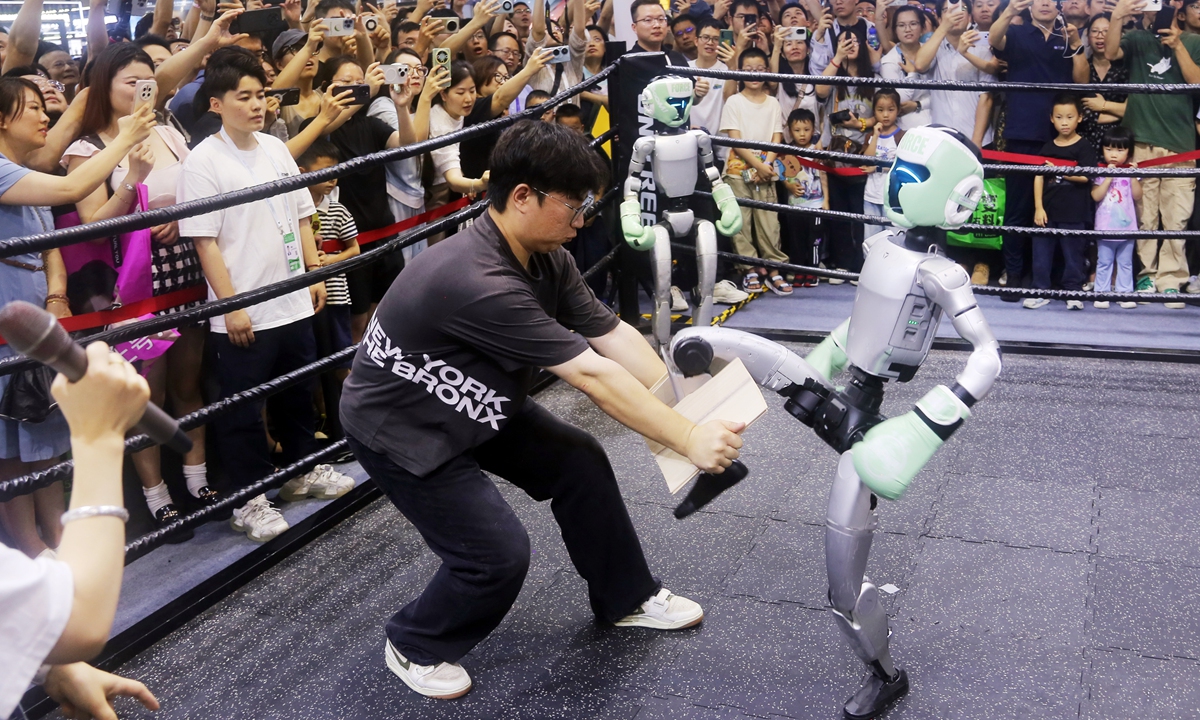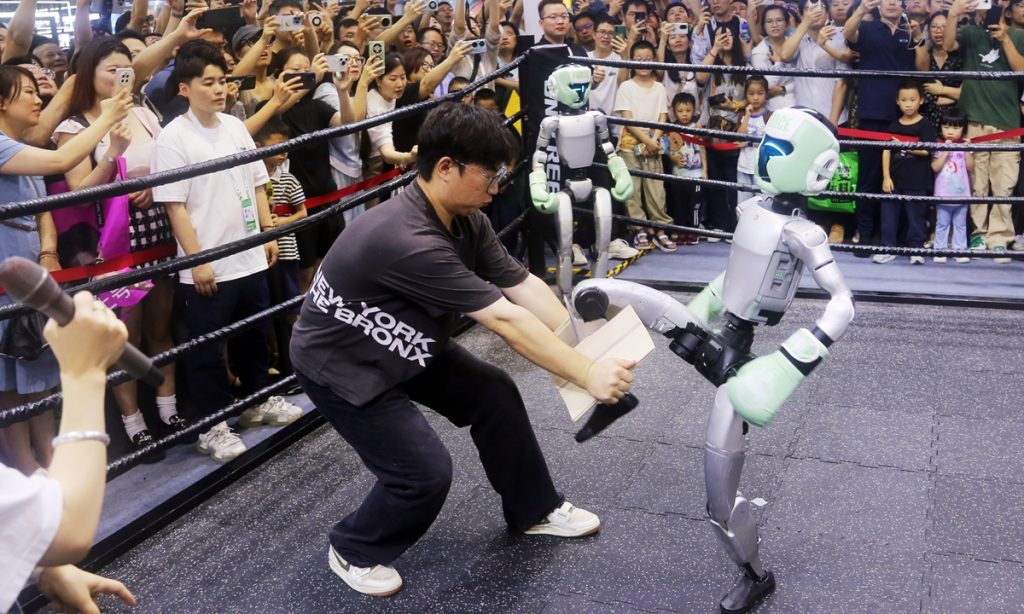
A humanoid robot developed by Unitree Robotics performs in a combat competition at the 2025 World Artificial Intelligence Conference on July 27, 2025. Photo: IC
The 2025 World AI Conference (WAIC) concluded on Monday in Shanghai, featuring four themed pavilions spanning over 70,000 square meters for the first time, with more than 800 enterprises showcasing over 3,000 cutting-edge exhibits and more than 100 global and China-first launches.
Hong Kong-based media outlet Wen Wei Po reported that trends such as large-scale model integration into robots and virtual humans, the rapid adoption of service and industrial robots, and diverse AI applications in daily life clearly indicate that AI is shifting from cloud-based algorithms to real-world operational terminals, with its implementation accelerating rapidly. Analysts noted that AI integration into everyday life is gaining speed in China.
On Saturday, the opening day of the WAIC, internet giants began intensively releasing large-scale model products. JD.com announced that its ChatRhino (Yanxi in Chinese) large language model was upgraded to JoyAI, offering models ranging from 3 billion to 750 billion parameters.
He Xiaodong, vice president of the JD.com Group, told media that based on their internal evaluations, the 750B model has ranked among the top in the world.
On Sunday, Alibaba showcased three newly open-sourced large-scale models in Shanghai. An Alibaba Cloud expert told the Global Times on Monday that these three models’ performance is comparable to leading closed-source models such as Claude 4 (released by US unicorn Anthropic in June), GPT-4.1 (released by US startup OpenAI in April), and Gemini 2.5 Pro (released by Google in March). Additionally, Tencent officially launched its Hunyuan3D World Model 1.0 on Sunday and announced it would be fully open-sourced.
As early as July 11, the Kimi K2 model, developed by Beijing-based Moonshot AI, was officially launched and simultaneously open-sourced. The prestigious scientific journal Nature hailed Kimi K2 as “another DeepSeek moment” for the global AI community.
US news outlet CNBC cited industry experts in an article in December 2024 saying that “Chinese AI models are already hugely popular and are keeping pace with – and even surpassing – some US rivals.”
Jensen Huang, CEO of US tech giant Nvidia, praised China’s rapid advancements in AI during his visit to Beijing in July, describing the Chinese market as both “large” and “dynamic.”
“AI is moving very fast in China,” Huang told media in Beijing, highlighting the thriving AI ecosystem in China and pointing to the abundance of startups and major cloud service providers.
“I can think of three reasons,” Du Yulun, a researcher at Moonshot AI, told Global Times on Sunday, explaining Kimi K2’s superior performance. “First, Kimi K2 is the first open-source model to match or even surpass top closed-source models in coding and agent tasks, proving Chinese companies can consistently produce world-class open-source models. Second, these achievements were made without access to cutting-edge GPUs, relying on algorithmic innovation, showing that computing restrictions cannot stop Chinese innovation. Third, we fully opened weights, training details, and commercial licenses, achieving over 200,000 downloads in two weeks, far exceeding all other open-source models, with integration into tools like Cursor,” he introduced.
“Model performance, technical innovation, and open-source accessibility are why the world again feels China’s unstoppable innovation,” Du concluded.
Bi Qi, chief scientist of China Telecom Corp Ltd and an academician at the Nokia Bell Labs in the US, told the Global Times that China’s “DeepSeek Moment” essentially reflects how Chinese AI companies are keeping pace with US innovation in technology while focusing on engineering and cost efficiency.
Starting from the low-to-mid-end market, they are rapidly achieving commercial models and gradually moving toward high-end development. “Although we may not be number one in technology compared to the US, being in second place does not hinder our commercial success,” the expert said.
Bi believes Chinese AI large-scale models have been remarkably successful, surprising many people. While large-scale models shine in natural language processing, their performance in image and video processing still needs to be upgraded to reach an acceptable commercial level. Moreover, the models and architectures for AI in other industries remain uncertain. How a breakthrough can be made into other commercial sectors and form a closed commercial loop is still under exploration.
At this year’s WAIC, public interest in robots was particularly high. In response, He noted that public expectations for AI technology are extremely high, making it easy for a single breakthrough to spark excitement. However, for practical applications, such as integrating robots into households, many challenges remain.
“For instance, many robotic hand movements still need to be addressed. Although hands are small, they have many joints. We’ve seen robots perform front flips and backflips, but in terms of degrees of freedom, those movements are far less complex than those of a hand.”
Bi told the Global Times that being at the WAIC in Shanghai and witnessing companies enthusiastically showcasing various exhibits, one can feel that China’s momentum in AI application development is strong, with everyone embracing AI. “If AI can generate profits, China has the potential to rank among the top in the world.”

